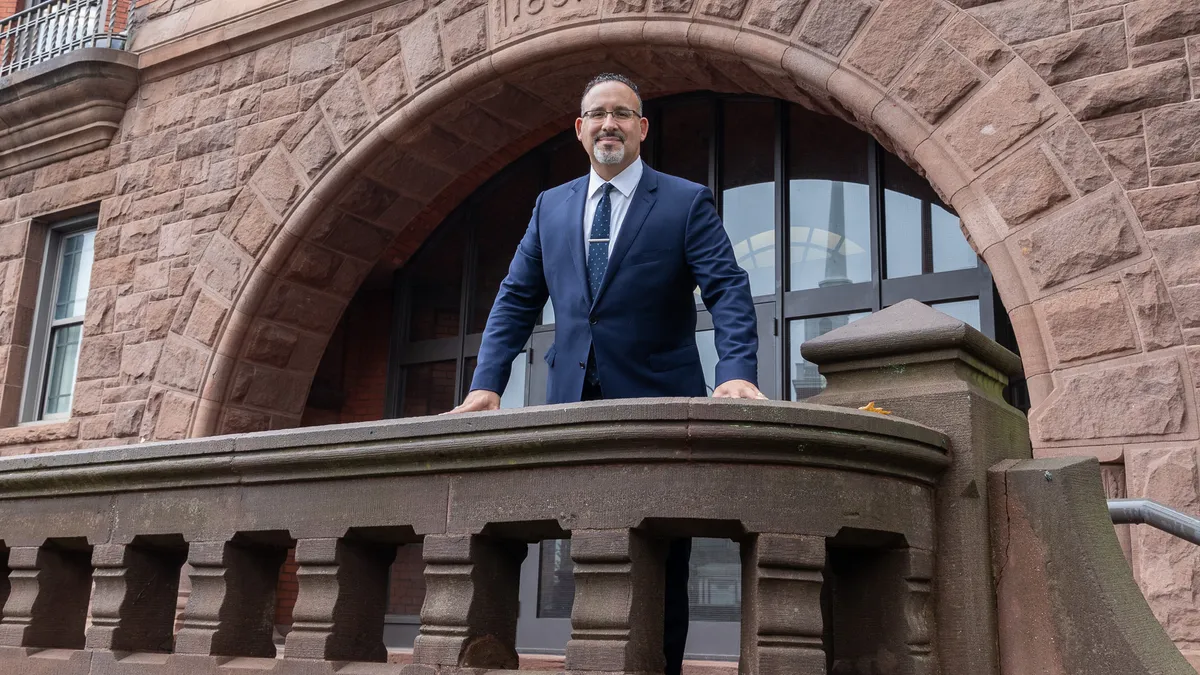Dive Brief:
- U.S. Department of Education officials on Tuesday announced fixes to what they described as "inexcusable" pitfalls with the student loan system, saying they will cancel debts of tens of thousands of borrowers.
- The agency focused on income-driven repayment, or IDR, which locks borrowers into a 20- or 25-year plan that has them pay off debt based on the amount they earn. Any remaining balance on a borrower's tab is wiped away after a plan's payment period ends. The Education Department said Tuesday all borrowers' past payments on Direct Student Loans and Federal Family Education Loan Program loans will now qualify toward having loan debt forgiven under IDR, regardless of their type of repayment plan.
- The department also said borrowers who entered forbearance — which temporarily allows for no or small monthly payments — for more than 12 months consecutively, or 36 months total, will have that forbearance period count toward IDR. It said forbearance will also count toward Public Service Loan forgiveness, or PSLF, which cancels the debt of certain workers who make 10 years of on-time payments.
Dive Insight:
The Education Department under President Joe Biden has made patching the troubled student financial aid system a priority and tried to ensure vulnerable borrowers receive loan forgiveness.
While the Trump administration frequently opted not to cancel loan debt, Biden's Education Department has moved to loosen requirements around such programs as PSLF.
Congress constructed PSLF in 2007 to allow those entering government or nonprofit work the opportunity to have their debts erased if they made a decade of qualifying payments. Yet the program has historically been an administrative horror, with borrowers often rejected from loan cancellation because of bureaucratic flaws.
The Biden administration has wiped out $6.8 billion in debt for more than 113,000 borrowers under PSLF.
Typically, borrowers pursue PSLF relief through income-driven plans. But they too have come under fire. In March 2021, the National Consumer Law Center, a nonprofit group, published data indicating that despite IDR plans existing for more than 25 years, at the time only 32 borrowers ever had their debts canceled through the program.
The department said Tuesday loan servicers had improperly shepherded borrowers into forbearance rather than income-driven repayment plans, a practice called forbearance steering. Both avenues grant income-strapped borrowers a reprieve, but in forbearance borrowers' loans still accrue interest, potentially compounding their financial troubles.
Agency officials said servicers' use of long-term forbearance was "remarkably widespread." More than 13% of borrowers between July 2009 and March 2020 who took loans directly from the department ended up in forbearance for at least 36 months, according to the department. Education Department regulations and loan servicer contracts generally limit discretionary forbearance use to 36 months cumulatively.
"Student loans were never meant to be a life sentence, but it's certainly felt that way for borrowers locked out of debt relief they're eligible for,” Education Secretary Miguel Cardona said in a statement.
The agency's actions effectively provide a credit for borrowers seeking loan forgiveness who were in forbearance. A borrower who spent more than a year straight in forbearance would be credited with 12 months of qualifying payments toward cancellation.
Officials estimate 3.6 million borrowers will receive at least three years of new credits toward loan forgiveness. "Several thousand" borrowers with older loans will see forgiveness under IDR, according to the department.
Borrowers who receive enough credit to have their loan canceled under IDR will have it done automatically. The Education Department expects 40,000 borrowers to have their debts cleared immediately under the PSLF program.
Furthermore, the Education Department is beefing up oversight of loan servicers to monitor whether they are inappropriately pushing students into forbearance. The Federal Student Aid office will restrict servicers' ability to enroll borrowers into forbearance by text or email, as well as work with the Consumer Financial Protection Bureau to regularly audit forbearance use.
Loan servicers will also receive new department guidance to better track income-driven payments. More significantly, Federal Student Aid said that beginning next year, it will monitor IDR payments through its own system and post borrowers' progress to its website.
This change comes on the heels of an NPR investigation that found widespread flaws in how servicers counted IDR payments, sometimes not doing so at all.
Political pressures were ramping up on income-driven repayment plans. The chairs of the House and Senate education committees on Monday urged Cardona to reform IDR and create income-driven plans available to all student borrowers.
The chair of the Senate education committee, Patty Murray, a Washington state Democrat, celebrated the department's changes. She said in a statement Tuesday they are an "urgently-needed step in the right direction," and repeated her call for broader IDR availability.















